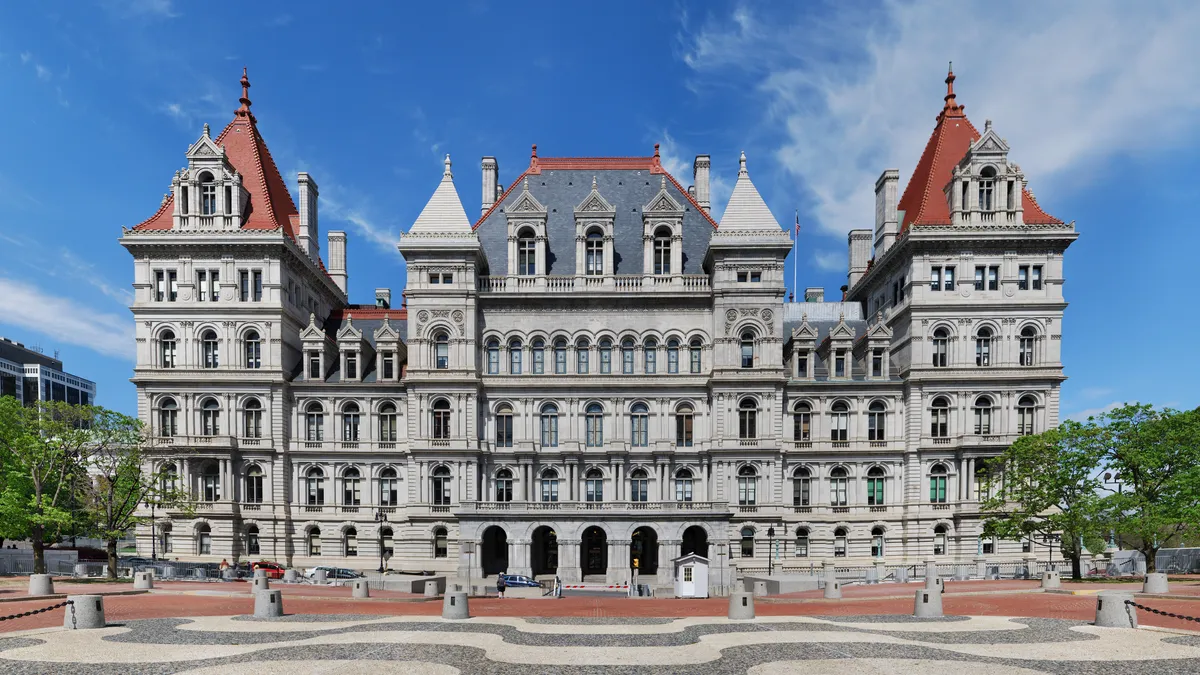New York could soon join the ranks of a handful of states that have adopted measures aimed at promoting energy storage.
The legislature last week passed bills (SB 5190 and AB 6571) directing that state’s Public Service Commission to develop an Energy Storage Deployment Program, including a storage procurement target for 2030. The program would be run by the New York Energy Research and Development Authority (NYSERDA) and the Long Island Power Authority (LIPA).
The legislation still has to be signed into law by Gov. Andrew Cuomo (D), but it would put New York in the company of California, Oregon, Maryland, Nevada and Massachusetts, which have all passed some form of legislation designed to encourage energy storage.
It is a precedent-setting move by New York and comes as part of a movement gathering strength across the nation, said Timothy Fox, vice president at Clearview Energy Partners.
There is a great deal of variation among states’ energy storage incentives. California, for instance, has established specific energy storage mandates for the state’s three investor-owned utilities, while Maryland’s program simply calls for an energy storage tax credit.
The details of New York’s program will not be known until the PSC fleshes out the details, but it is notable that the language in the legislation calls for a “target,” not a “mandate.”
The measure establishes targets instead of mandates “because this is an evolving technology, so we want to be able to give the Public Service Commission some discretion and flexibility in setting targets for what can be achieved over an extended period of time," Sen. Joseph Griffo (R), one of the sponsors of the bill, wrote in an email.
“This approach would also ensure that a mandate does not apply to only one particular type of technology like energy storage over another, like fuel cells, for example," Griffo wrote.
The main aim of the law is to support New York’s 50%-by-2030 renewable portfolio standard. “Expanding energy storage is critical for New York to meet its goals by enabling renewable energy to be used continuously, reducing the need for energy produced using fossil fuels,” Assemblywoman Amy Paulin (D), another sponsor of the bill, said in a statement.
“We didn’t want to mandate the specifics,” Paulin said in an interview. But while a target could be voluntary, it would have to have “teeth,” she said.
California’s energy mandate is just one technique in meeting that goal, Paulin said, adding that New York’s PSC can be “very creative.”
Paulin said the storage legislation is modeled on the NY-Sun program launched by Gov. Cuomo in 2012.
NY-Sun – administered by NYSERDA, LIPA, PSEG Long Island, and the New York Power Authority (NYPA) – committed $1 billion to stimulate the market for solar power over a 10-year period. The program aims to add more than 3,000 MW of solar capacity in the state by 2023.
NY-Sun has brought about a 181% rise in the state’s non-residential solar power market, according to a report by GTM Research and the Solar Energy Industries Association.
Despite the non-specific language, “we expect New York to adopt a mandate,” said ClearView's Fox. The storage bills enjoyed nearly unanimous support in the legislature, he noted, and they align with Gov. Cuomo’s Reforming the Energy Vision initiative.
Energy storage could also help the state address some of the problems it is having bringing renewable energy in upstate and western parts of the state into downstate load centers, as well as assist in alleviating some of the problems stemming from the state’s aging transmission infrastructure, which is among the oldest in the nation.
“This legislation will help accelerate deployment of important storage resources on the state’s electric grid,” William Acker, executive director of the New York Battery and Energy Storage Technology (NY-BEST) consortium, said in a statement.
Mandate expected
Fox said Massachusetts, whose legislature passed a law laying the groundwork for an energy storage mandate last summer, could finalize that mandate as early as the end of this month.
Massachusetts could set an ambitious mandate, said Fox, establishing a high water mark for energy storage on the East coast. And that, he said, could embolden New York in setting its storage target.
Right now, California and California and Massachusetts serve as the benchmarks for energy storage targets, noted Ravi Manghani, director, energy storage, at GTM Research. Those states have proposed or recommended that 3% to 5% of peak load be served by energy storage in the next six (California) to eight (Massachusetts) years.
Using the same math and factoring in declines in energy storage technology expected by the time New York’s program draws to an end in 2030, Manghani estimates an energy storage target for New York in the range of 1 GW to 1.6 GW.
“All three states have unique grid conditions and renewable goals, but given the leadership New York has exhibited through rethinking the state grid, it won't be a surprise if we see a target at the higher end of the range,” he said.
Fox noted that the states that have adopted energy storage legislation so far have used similar language about their objectives. Energy storage is being embraced by states that are already leaning toward green energy.
“They don’t speak about fuel diversity," Fox said. “Green states are getting greener."
It is also another instance of “regulatory rollback rebound,” Fox added, in the wake of President Donald Trump’s efforts to rescind or reverse the greenhouse gas mitigation measures put in place or begun during the Obama administration.
Fox says he “fully expects” Cuomo to sign the energy storage bill into law and that the final regulations could be completed by December in time for the 2018 target implementation date.
Paulin says she is “very hopeful” Cuomo will sign the bill, but noted that it is the end of the legislative session and a lot of bills are headed to the governor’s desk for his signature.






















